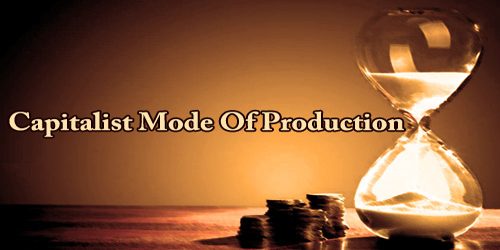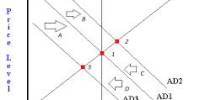Capitalism is based on private ownership of enterprises such as factories, plantations, mines, offices or shops, and the operation of these assets for profit. Other elements of the means of production such as labor, land, technology, and capital are also privately owned and can be bought and sold.
Labor is the most important input for production. Under capitalism, labor, the work of men and women, has become a special type of commodity which is sold in the marketplace. Capitalists use their money to buy labor and combine this commodity with other inputs, such as land, raw materials, etc. to produce new goods and services. In profitable businesses, the economic value of these new goods and services are greater than the other inputs required to produce them.
The concept of the capitalist mode of production (CMP) occupies a central place in Karl Marx’s (1818–1883) view of productive relations, forms of exploitation, and conflict in modern society. The very notion of capitalism was used predominantly by Marxists well into the twentieth century when it started to be thoroughly analyzed in a non-Marxist perspective by Max Weber (1864–1920) and Werner Sombart (1863–1941).
The capitalist mode of production proper based on wage-labor and private ownership of the means of production and on industrial technology, began to grow rapidly in Western Europe from the Industrial Revolution, later extending to most of the world. The capitalist mode of production is characterized by private ownership of the means of production, extraction of surplus value by the owning class for the purpose of capital accumulation, wage-based labor, and at least as far as commodities are concerned being market-based.
The capitalist mode of production was different to earlier feudalism because of the role for waged labor and the importance of capital and markets for acquiring wealth. The important transitions which lead to the expansion of capitalism around the globe through colonialism was the concentration of capitalist power through the fusion of state authority and capital.
Marxist theory –
In his work, especially the Grundrisse (1857–1858) and the first volume of Capital (1867), Karl Marx defined capitalism as a mode of production (CMP) characterized by the separation of the direct producers, the working class, from the means of production or the productive assets, which are controlled by the bourgeoisie as private property. Ownership of the means of production enables the bourgeoisie to organize the industrial labor process, where individual workers are driven to seek employment by the needs of their own reproduction. Contrary to previous modes of production such as slavery and feudalism, the laborer is compelled to enter an employment relation not by external compulsion, but by economic necessity.
As a result, the employment relationship is formally an individual contractual transaction between bourgeois capitalists and workers, who are juridically free. Once they enter the capitalist labor process, workers are remunerated with a wage, a monetary sum representing the “exchange value” with which the capitalist purchases the worker’s labor power. The wage is expressed in terms of the duration of the working day and is calculated on the basis of the goods that workers need to reproduce their ability to work. Therefore, the wage does not recognize specific forms of labor or skills; it only compensates “abstract” labor power.
In the productive process, workers operate machines and other means of production with which they create commodities whose values exceed workers’ remunerations. When capitalists sell commodities on the market, “realizing” their value, they, therefore, appropriate the difference between the value of such goods and the value of the labor power used to produce them. Marx calls this difference “surplus value,” which for him is the defining feature of the exploitative nature of capitalism. The money capitalists earn from realizing their surplus-value contains a profit, which capitalists reinvest to restart the productive cycle in what Marx calls “extended reproduction” of capital. Marx saw the origins of profit and surplus extraction in the very process of production, not in market dynamics of supply and demand, as in the “bourgeois” political economy of Adam Smith (1723–1790) and David Ricardo (1772–1823). Nonetheless, Smith and Ricardo influenced Marx’s concept of the division of labor and his “labor theory of value,” respectively. Marx, however, regarded the market not as a realm of free individual initiative, but as an institution that materializes human exploitation and alienation.
Marx argued that capital existed incipiently on a small scale for centuries in the form of merchant, renting and lending activities and occasionally also as small-scale industry with some wage labor (Marx was also well aware that wage labor existed for centuries on a modest scale before the advent of capitalist industry). Simple commodity exchange and consequently simple commodity production, which form the initial basis for the growth of capital from trade, have a very long history. The “capitalistic era” according to Marx dates from the 16th century, i.e. it began with merchant capitalism and relatively small urban workshops.
For the capitalist mode of production to emerge as a distinctive mode of production dominating the whole production process of society, many different social, economic, cultural, technical, and legal-political conditions had to come together.
For most of human history, these did not come together. Capital existed and commercial trade existed, but it did not lead to industrialization and large-scale capitalist industry. That required a whole series of new conditions, namely specific technologies of mass production, the ability to independently and privately own and trade in means of production, a class of workers compelled to sell their labor power for a living, a legal framework promoting commerce, a physical infrastructure making the circulation of goods on a large scale possible, security for private accumulation and so on. In many Third World countries, many of these conditions do not exist even today even though there is plenty of capital and labor available the obstacles for the development of capitalist markets are less a technical matter and more a social, cultural and political problem.
For Marx, the CMP is a social process riddled with contradictions that originate from its own “laws of motion.” The growing “concentration” of accumulated capital is what ultimately allows individual capitalists to increase their profits and drive competitors out of the market. The elimination of uncompetitive capitals produces a centralization of ownership in a smaller number of large companies. But successful competition also requires increasing investment in machinery (“constant capital”). As a result, the surplus value extracted from human labor is eroded and, in the long term, the rate of profit for the CMP as a whole tends to fall. In the process, masses of workers are expelled from the production process and end up swelling the unemployed “relative surplus population.”
Marx described the laws of motion in the CMP far more precisely than in other modes of production. His aim was in fact to scientifically demonstrate how the demands of the working class are ultimately incompatible with capital’s exploitative nature. As the contradictions of the CMP manifest themselves in periodic crises, workers become conscious of their own exploitation as a class. Therefore they organize to accelerate capitalism’s eventual demise and establish a socialist society where class domination is abolished.
Marx tended to present the development of the CMP as a social dynamics whose general laws of motion could be scientifically ascertained. He was nonetheless quite aware that the process he described was historically specific and located largely in Western Europe. England had for him a prototypical CMP. There, the birth of capitalist agriculture and the rise of mechanized manufacturing in the late eighteenth and early nineteenth centuries enabled the Industrial Revolution, which benefited from world trade and technological innovation. Marx associated the rise of capitalism with the establishment of a form of state whose laws and institutions protect private property, capital accumulation, and formal liberties that enable contractual relations between workers and capitalists. This stage of political development is represented by the liberal state, whose juridical and ideological “superstructure” is functional to reproduce the “base” of capitalist relations of exploitation.
A society, a region or nation is “capitalist” if the predominant source of income and products being distributed is a capitalist activity, even so, this does not yet mean necessarily that the capitalist mode of production is dominant in that society.
Information sources:
















